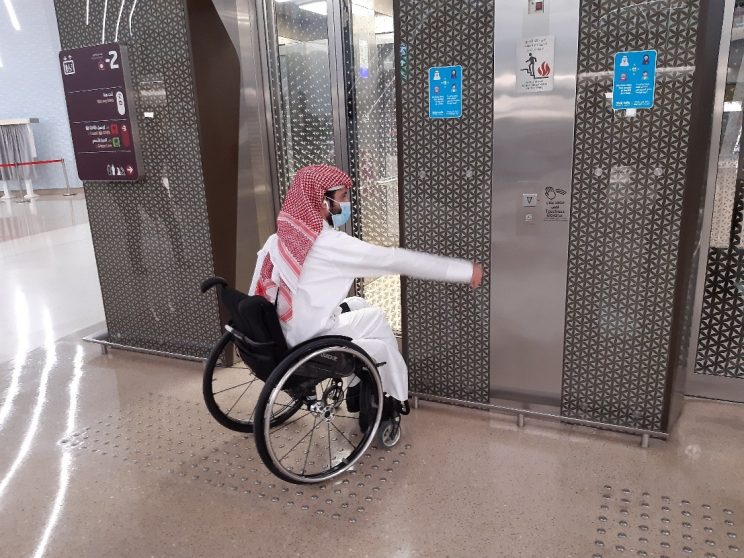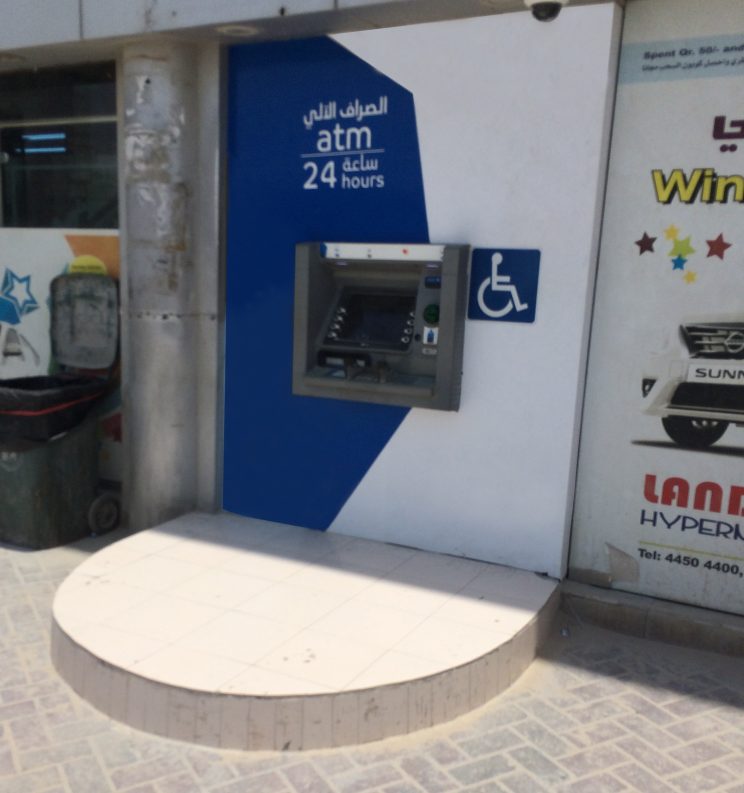Building a Barrier-Free Built Environment: Mada’s Vision for an Accessible Qatar
Research article  Open access |
Available online on: 16 September, 2025 |
Last update: 16 September, 2025
Open access |
Available online on: 16 September, 2025 |
Last update: 16 September, 2025
Abstract-
This paper explores the Mada Center’s national initiative to promote a barrier-free built environment in Qatar through the implementation of universal design principles. The paper highlights the significance of inclusive urban planning and architecture for ensuring accessibility and participation for people with disabilities and aging populations. Drawing on global literature and the Center’s advisory and training services, this work situates Mada’s model within international best practices.
Keywords- Universal Design; Accessibility; Built Environment; Disability Inclusion; Urban Planning.
1. Introduction
An inclusive built environment is essential for creating equitable, accessible public spaces that serve individuals across all levels of ability. Accessibility in architecture and urban design ensures that everyone, including persons with disabilities, can move independently, safely, and with dignity. This principle is central to fulfilling international frameworks like the UN Convention on the Rights of Persons with Disabilities and aligns with sustainable urban development goals [1]. The challenges in existing urban environments, from inaccessible sidewalks and transportation hubs to public facilities, continue to marginalize individuals with mobility, sensory, or cognitive impairments [2]. This necessitates the need for proactive universal design strategies that prioritize inclusion from the outset rather than as retrofitted solutions.
Research shows that accessible design not only improves quality of life for people with disabilities but also enhances usability and comfort for broader populations, including older adults and families with young children [3]. Furthermore, participatory approaches and inclusive post-occupancy evaluations have proven effective in identifying and resolving accessibility barriers across diverse urban contexts [4].
This paper explores the ongoing efforts of the Mada Center to implement a nationwide accessibility framework in Qatar through the application of universal design principles. It situates this initiative within contemporary global efforts to build barrier-free urban environments and highlights the evidence base supporting inclusive urban design as a tool for empowerment and social cohesion.
2. Advancing Accessibility Through Universal Design
Universal design refers to the practice of creating environments that are accessible to all individuals, regardless of ability, age, or circumstance. This concept is not merely a technical standard; it is a proactive approach to human diversity in the built environment. Originally rooted in advocacy for people with disabilities, universal design today also embraces the needs of aging populations, children, and those with temporary injuries or different sensory abilities.
- Benefits of Universal Design for All Populations
Universal design solutions benefit a wide range of users. For example, curb cuts initially intended for wheelchair users now benefit parents with strollers, travelers with luggage, and workers with carts. These inclusive features not only address physical access but also contribute to autonomy, safety, and usability. Recent studies confirm that barrier-free crossings, rest points, and clear wayfinding systems improve mobility for both older adults and persons with disabilities, highlighting significant overlaps in their needs [3]. Similarly, public buildings designed with universal accessibility in mind benefit not just people with disabilities but also women, children, the elderly, and visitors unfamiliar with the environment [5].
- Housing and Urban Adaptability for the Aging
The aging population increasingly requires environments that promote independence and reduce physical strain. Design elements such as wide doorways, step-free entries, tactile flooring, and adjustable-height countertops enable aging in place and reduce fall-related injuries. Universal design in home and community settings is essential for safe and inclusive living. During COVID-19, the importance of spatial features like single-level layouts and clear visual cues became even more evident, especially for elders with reduced mobility or cognitive decline [6]. Studies highlight how the same design interventions serve both older adults and people with disabilities, enhancing daily autonomy and reducing institutional care dependence [7].
- Disability-Centered Design and Co-Creation
Including people with disabilities in the design process leads to more authentic and effective built environments. Co-design practices, where disabled users collaborate with planners and architects, produce outcomes that reflect real-world needs and enhance usability. A recent Australian case study found that such participation not only improves physical accessibility but fosters dignity and community connection through inclusive public architecture [8].
- Social Inclusion and Policy Relevance
Universal design fosters social equity by supporting civic engagement, reducing stigma, and enhancing psychological comfort. This has policy relevance across sectors, not limited to education, public transport, healthcare, housing, and others. Studies underscore that inclusive design in public infrastructure increases social interaction and reduces the dependence of marginalized users on caregivers [8]. Furthermore, adopting universal design from the start significantly reduces future retrofitting costs and minimizes exclusionary consequences, making it a financially responsible planning strategy [7].
3. Mada’s Contributions to Accessibility in Qatar
Mada is pioneering accessible built environment in Qatar. This initiative ensures that everyone, regardless of disability, can navigate and use public spaces with ease. As of 2025, Mada is the first organization in the country to officially provide Accessible Built Environment consultation services. It advises public and private entities on inclusive design based on global standards like the ADA (Americans with Disability Act). Its services include:
- Inclusive design audits of new infrastructure.
- Professional training programs.
- Advisory compliance with international guidelines.
These efforts are reshaping Qatar’s public realm, ensuring that features like ramps, tactile paving, and accessible signage are becoming standard. Mada’s role fills a crucial gap in the region, where such services were previously unavailable.
 Figure 1: Photo of Person with Disability in wheelchair. Mada assignment to review accessibility journey in the Doha Metro. Photo of person checking the accessibility of the lift.
Figure 1: Photo of Person with Disability in wheelchair. Mada assignment to review accessibility journey in the Doha Metro. Photo of person checking the accessibility of the lift.
 Figure 2: Photo of an inaccessible ATM in Doha. The accessibility team found many inaccessible ATM in their work with Qatar central Bank throughout the country.
Figure 2: Photo of an inaccessible ATM in Doha. The accessibility team found many inaccessible ATM in their work with Qatar central Bank throughout the country.
Regionally, similar work is emerging. In Malta, UD has become legally binding, integrated into planning laws [9], while in Malaysia, accessibility consultants are embedding inclusive strategies within national policy [10]. A Middle East smart city case study from Doha also emphasizes how digital and physical design must go hand-in-hand to ensure equitable urban experiences [11]. In the broader Middle East, efforts remain fragmented, though growing. Initiatives such as the Alexandria Smart City Universal Design project emphasize the need to embed accessibility within digital and sustainable city frameworks [12]. In Qatar, however, Mada’s centralized and cross-sectoral approach remains a unique and leading model for accessibility transformation.
4. Conclusion
Mada’s leadership in implementing universal design in Qatar signals a broader cultural shift toward inclusion and accessibility in the built environment. By placing people with disabilities at the center of design, and aligning its programs with global accessibility standards, Mada is ensuring that Qatar’s development is inclusive, equitable, and future-ready.
Urban inclusion is not a luxury; it is a right. Mada’s work demonstrates that designing for all is not only possible but essential in building societies where everyone can thrive.
References
[1] V. Pineda, ‘What is Inclusive and Accessible Public Space?’, J. Public Space, 2022, doi: 10.32891/jps.v7i2.1607.
[2] R. P. Singh and J. Dhakal, ‘Accessibility and Disability-Inclusive Urban Planning in Kathmandu Metropolitan City’, Int. Res. J. MMC, 2024, doi: 10.3126/irjmmc.v5i1.63080.
[3] A. Ramírez-Saiz, M. T. B. Larriva, D. J. Martín, and A. Alonso, ‘Enhancing Urban Mobility for All: The Role of Universal Design in Supporting Social Inclusion for Older Adults and People with Disabilities’, Urban Sci., 2025, doi: 10.3390/urbansci9020046.
[4] G. Güvenbaş and M. Polay, ‘Post-occupancy evaluation: A diagnostic tool to establish and sustain inclusive access in Kyrenia Town Centre’, Indoor Built Environ., vol. 30, pp. 1620–1642, 2020, doi: 10.1177/1420326X20951244.
[5] Ü. Duman and K. Uzunoğlu, ‘The Importance of Universal Design for the Disabled in Public Buildings: A Public Building in Northern Cyprus as a Case Study’, Civ. Eng. Archit., vol. 9, pp. 690–707, 2021, doi: 10.13189/CEA.2021.090312.
[6] O. Chrzanowska, ‘Universal Design Principles for Older People and Older People with Disabilities During the COVID-19 Pandemic’, Interdiscip. Context Spec. Pedagogy, vol. 31, pp. 267–286, 2020, doi: 10.14746/ikps.2020.31.12.
[7] S. Shkliar and O. Shushliakova, ‘UNIVERSAL DESIGN AS THE BASIS OF FORMING AN ACCESSIBLE ARCHITECTURAL ENVIRONMENT OF MODERN CITIES’, Urban Dev. Spat. Plan., 2023, doi: 10.32347/2076-815x.2023.82.350-363.
[8] V. Watchorn, R. Tucker, D. Hitch, and P. Frawley, ‘Co-design in the context of universal design: An Australian case study exploring the role of people with disabilities in the design of public buildings’, Des. J., vol. 27, pp. 68–88, 2023, doi: 10.1080/14606925.2023.2264652.
[9] L. Bianco, ‘Universal design: from design philosophy to applied science’, vol. 10, pp. 70–97, 2020, doi: 10.17411/JACCES.V10I1.249.
[10] N. A. A. Samad, I. Said, and A. Rahim, ‘Strategies of Accessible City for Malaysia as A Developing Country’, Environ.-Behav. Proc. J., 2021, doi: 10.21834/ebpj.v6isi4.2913.
[11] V. Geropanta, ‘The Smart City in Relation to Its Environment, Perception, and Urban Planning Process: Lessons for Developing Countries’, pp. 547–561, 2020, doi: 10.1007/978-3-030-25879-5_25.
[12] N. S. A. Abdelmaksoud, ‘UNIVERSAL DESIGN APPROACH TO A SMART, SUSTAINABLE, SAFE, AND ACCESSIBLE CITY FOR ALL’, WIT Trans. Ecol. Environ., 2022, doi: 10.2495/sc220211.
